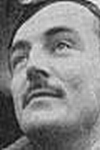Crossley, Michael Nicholson "Red Knight"
- Date of birth:
- May 29th, 1912 (Halford/Warwickshire, Great Britain)
- Date of death:
- September 1987
- Nationality:
- British (1801-present, Kingdom)
Biography
Service number 37554.
Michael Crossley was educated at Eton College and The College of Aeronautical Engineering in Chelsea before he joined the RAF in 1936. He was posted to No. 32 Squadron after training, and became a Flight Commander of Red Flight ust before the outbreak of war, hence his nickname.
His unit was constantly in action in May 1940, commencing on the 11th when a strafing attack on German troop-carrier aircraft at Ypenburg airfield, Holland, was undertaken.
He was promoted to command the squadron after the departure of John Worrall to Biggin Hill on 16th but two days later was shot down by Me 109's, baling out unharmed. He was shot down again on the 24th, again escaping unhurt. He remained with the unit until April 1941, when he was sent to the USA to act as a test pilot for the British Air Commission there. On return to the UK in 1943, he was sent to lead the Detling Wing, However, he contracted tuberculosis which put an end to operational flying. His total number of victories was 20 and 2 shared destroyed.
He was released from the RAF in 1946.
Michael Crossley then emigrated to South Africa to farm, where he died in 1987.
Promotions:
August 7th, 1939: Flight Lieutenant
August 9th, 1940: Squadron Leader
September 1st, 1942: Wing Commander (temporary).
Do you have more information about this person? Inform us!
- Period:
- Second World War (1939-1945)
- Rank:
- Acting Flight Lieutenant
- Awarded on:
- June 21st, 1940
"In June, 1940, this officer was the leader of two squadrons of fighters which were carrying out an offensive patrol in the Le Treport area. Flight Lieutenant Crossley sighted seventeen Heinkel 111's, and displayed outstanding initiative and courage in his method of attack. As a result of the engagement seven enemy bombers were destroyed. Flight Lieutenant Crossley himself destroyed two, and had to break off a further fight as his ammunition was expended. He had his first combat in May, 1940, when he succeeded in destroying a Messerschmitt 109. He has displayed exceptional skill and leadership and, since the middle of May, 1940, has destroyed seven enemy aircraft."
- Period:
- Second World War (1939-1945)
- Rank:
- Acting Squadron Leader
- Awarded on:
- August 20th, 1940
"This officer has led his section, flight and squadron with skill and courage and has flown almost continuously since the commencement of hostilities. Since May, he has participated in engagements against the enemy over Holland, Belgium and France, including patrols over Dunkirk and St. Valery during the evacuation operations. In August he destroyed two Junkers 88 over Portsmouth and assisted in the destruction of another over Croydon. During the latter engagement he encountered another Junkers 88 and, having expended all his ammunition, acted as above guard until two of his section finally destroyed it. The next day he destroyed three enemy aircraft. Squadron Leader Crossley has now destroyed a total of eighteen enemy aircraft and possibly another five. He has displayed rare qualities as a leader; his example of courage and tenacity of purpose have proved an inspiration to other members of his squadron."
- Period:
- Second World War (1939-1945)
- Rank:
- Acting Squadron Leader
- Awarded on:
- January 1st, 1941
- Period:
- Second World War (1939-1945)
- Rank:
- Wing Commander
- Unit:
- Reserve of Air Force Officers
- Awarded on:
- January 1st, 1946
Sources
- Photo 1: Aces of WW2 Homepage
- Photo: Aces of WW2 Homepage
- - SHORES, CH. & WILLIAMS, C., Aces High, Grub Street, London, 1994.
- The London Gazette Issue 34878 published on the 21 June 1940
- The London Gazette Issue 34935 published on the 30 August 1940
- Supplement to The London Gazette Issue 35029 published on the 31 December 1940
- Supplement to The London Gazette Issue 37407 published on the 28 December 1945






